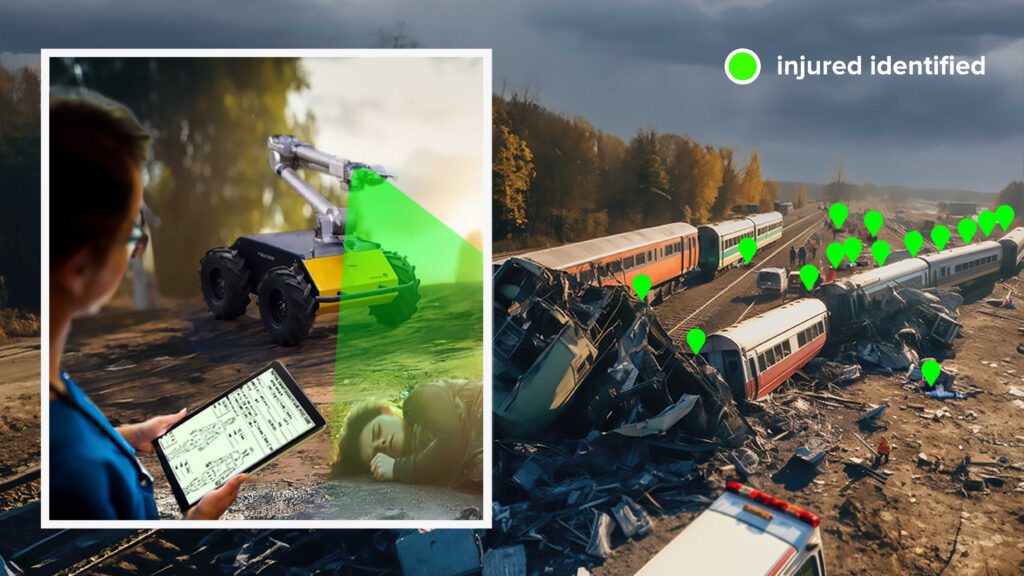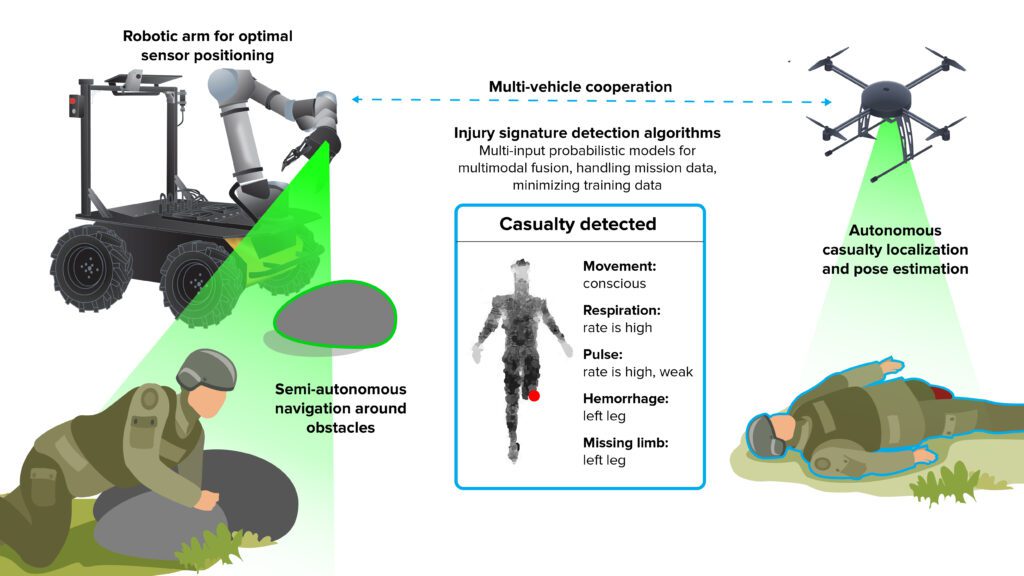POINTER
A robotic medical triage system that aids
medics during a mass casualty incident
A robotic medical triage system that aids medics during a mass casualty incident
Point of Injury Navigation, Triage, and Emergency Response (POINTER)
In the devastating aftermath of mass casualty incidents (MCIs), there’s a very slim “golden window” where lives can still be saved. The POINTER robotic platform helps medics do their job more effectively in such a time- and resource-constrained environment.
Charles River is one of 11 teams that participated in the DARPA Triage Challenge (DTC) Systems track. The goal of the DTC is to spur innovations in medical triage in civilian and military settings.

Situational awareness for medics
MCIs frequently overwhelm medical resources due to high demand, chaotic circumstances, or dangerous conditions. Autonomous systems can play a crucial role in enhancing situational awareness, allowing medical personnel to identify and address the most critical injuries quickly, ultimately maximizing lives saved. POINTER is specifically designed to gather essential information that aids in rapid medical triage.

Autonomous triage system for MCIs
POINTER is a robotic platform that uses casualty localization to identify and navigate to injured humans then perform basic initial triage to report injury status to medics. While POINTER is a multimodal, multivehicle platform, the Charles River team’s immediate focus was on the ground in the form of uncrewed ground vehicles (UGVs) equipped with a robotic arm. For POINTER to be effective, it must accurately measure signs of injury. The system follows the MARCH protocol—standing for Massive Hemorrhage, Airway, Respiration, Circulation, Hypothermia/Head injury—adopted by Special Ops forces to prioritize casualty care.
“There’s a lot of interesting data fusion that we can do with the POINTER sensors. The sensor modalities we have complement and support one another.”

Dr. Aaron Winder
Senior Scientist and Principal Investigator on POINTER
Sensor fusion for intelligent assessments
To conduct its evaluations, the robotic platform carries a range of sensors from cameras to more advanced vision systems like a laser speckle contrast imager to detect behavioral signs, visible injuries, heart rate, and respiration. The reliance on several modalities is intended to make POINTER more flexible to the austere, uncertain conditions of an MCI.
Especially promising is the ability to combine sensor data to paint a holistic picture of casualty status. The fusion of sensor modalities allows the system to capture precise data while increasing confidence in assessments and providing deeper insights into the nature of injuries. The POINTER sensor suite is positioned about one meter from the casualty using an articulated robotic arm. Features of injury detected by each modality are analyzed through computer vision and signal processing, then combined into a triage priority assessment. This information, along with the casualty’s location, is transmitted to medical personnel for a timely response.
“POINTER’s key advantage lies in its flexibility. Its diverse array of sensors requires accurate positioning, and the robotic arm’s adaptability is crucial for responding to the unexpected circumstances often encountered in casualty scenarios.”

Dr. Madison Clark-Turner
Robotics Scientist and Co-Principal Investigator on POINTER
Key advantages
Enhanced situational awareness
POINTER gathers critical information in chaotic conditions, enabling medics to prioritize care efficiently.
Adaptability in dynamic terrain
POINTER’s robotic arm and uncrewed vehicles navigate challenging environments with precision.
Multimodal sensing
The system’s diverse sensors, including cameras and advanced imaging systems, provide holistic injury assessments.
Timely data transmission
Injury assessments and casualty locations are quickly relayed to medics, maximizing response effectiveness.
Beyond the battlefield, POINTER is expected to have applications in terrorist or domestic incidents and natural disasters. Using POINTER to mitigate and minimize from the devastation of war or natural disasters serves as a powerful motivation in its development.
Contact us to learn more about POINTER and our other capabilities in health and medical, and robotics and autonomy.
This material is based upon work supported by the Defense Advanced Research Projects Agency under Contract No. HR0011-24-C-0345. Any opinions, findings and conclusions or recommendations expressed in this material are those of the author(s) and do not necessarily reflect the views of the Defense Advanced Research Projects Agency.
